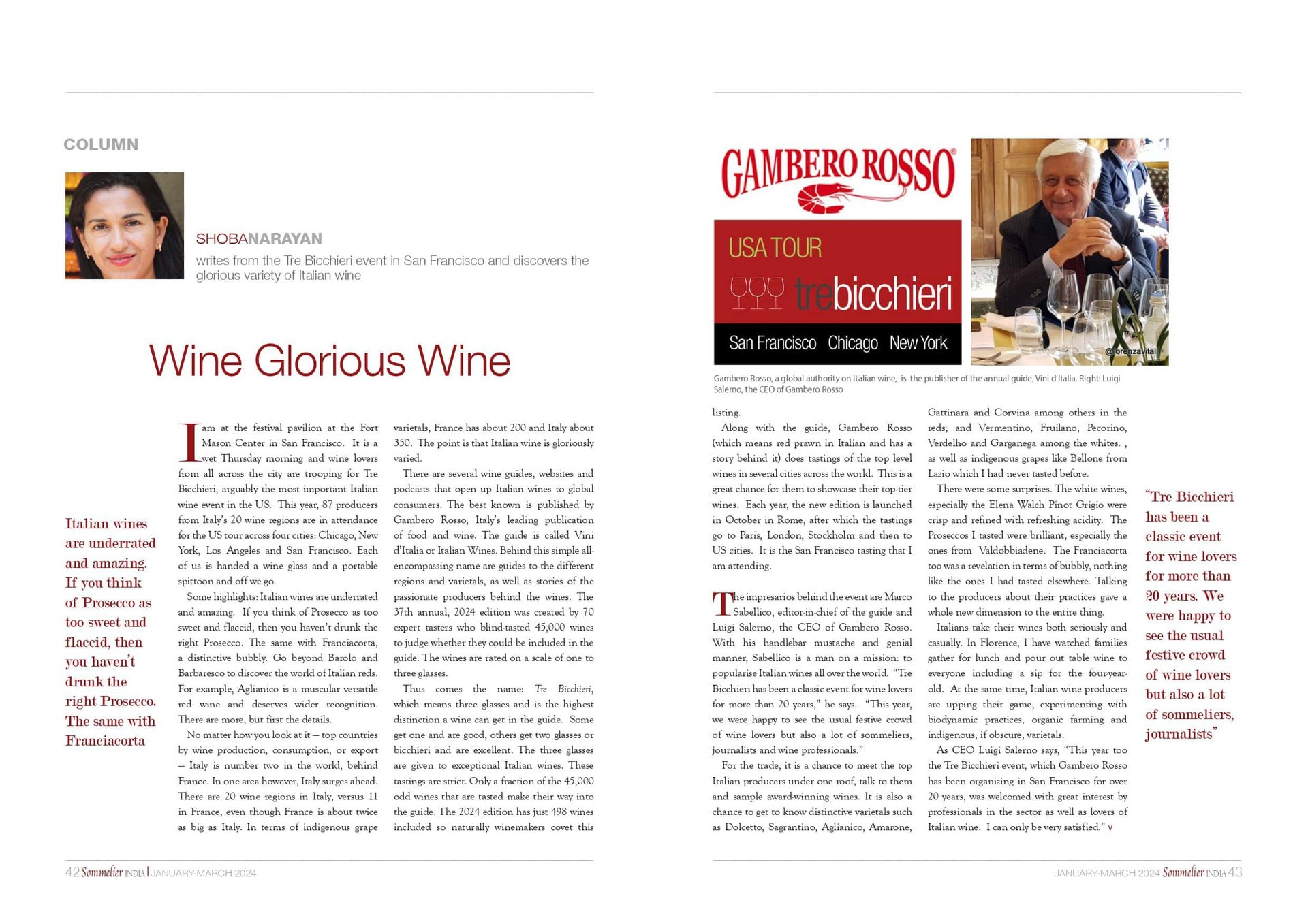I am at the festival pavilion at the Fort Mason Center in San Francisco. It is a wet Thursday morning and wine lovers from all across the city are trooping for Tre Bicchieri, arguably the most important Italian wine event in the US. This year, 87 producers from Italy’s 20 wine regions are in attendance for the US tour across four cities: Chicago, New York, Los Angeles and San Francisco. Each of us is handed a wine glass and a portable spittoon and off we go.
Some highlights: Italian whites are underrated and amazing. If you think of Prosecco as too-sweet and flaccid, then you haven’t drunk the right Prosecco. The same with Franciacorta, a distinctive bubbly. Go beyond Barolo and Barbaresco to discover the world of Italian reds. For example, Aglianico is a muscular versatile wine and deserves wider recognition. There are more but first the details.
No matter how you look at it— top countries by wine production, consumption, or export— Italy is number 2 in the world, behind France. In one area however, Italy surges ahead. There are 20 wine regions in Italy, versus 11 in France, even though France is about two times bigger than Italy. In terms of indigenous grape varietals, France has about 200 and Italy about 350. The point is that Italian wine is gloriously varied.
There are several wine guides, websites and podcasts that open up Italian wines to global consumers. The best known is published by Gambero Rosso, Italy’s leading publication of food and wine. The guide is called Vini d’Italia or Italian Wines. Behind this simple all-encompassing name are guides to the different regions, varietals, and also stories of the passionate producers behind the wines. The 37th annual 2024 edition was created by 70 expert tasters who blind-tasted 45,000 wines to judge whether they could be included in the guide and how these wines were rated. Thus comes the name: Tre Bicchieri which means three glasses, which of course, is the highest distinction a wine can get in the guide. Some get one and are good, others get two glasses or bicchieri and are excellent. The three glasses are given to exceptional Italian wines. These tastings are strict— only a fraction of the 45,000 odd wines that are tasted make their way into the guide. The 2024 edition has just 498 wines included so naturally winemakers covet this listing.
Along with the guide, Gambero Rosso (which means red prawn in Italian and has a story behind it) does tastings of the top level wines in several cities across the world. This is a great chance for them to showcase their top-tier wines. Each year, the new edition is launched in October in Rome, after which the tastings go to Paris, London, Stockholm and then to US cities. It is the San Francisco tasting that I am attending.
The impresarios behind the event are Marco Sabellico, editor-in-chief of the guide and Luigi Salerno, the CEO of Gambero Rosso. With his handlebar mustache and genial manner, Sabellico is a man on a mission: to popularize Italian wines all over the world. “Tre Bicchieri has been a classic event for wine lovers for more than 20 years,” he says. “This year, we were happy to see the usual festive crowd of wine lovers but also a lot of sommeliers, journalists and wine professionals.”
For the trade, it is a chance to meet the top Italian producers under one roof, talk to them and sample award-winning wines. It is also a chance to get to known distinctive varietals such as Dolchetto, Sagrantino, Aglianico, Amarone, Gattinara, Corvina among others in the reds; and Vermintino, Fruilano, Pecorino, Verdello and Garganega among the whites. There were some indigenous grapes like Bellone from Lazio which I had never tasted before.
There were some surprises. The white wines, especially the Elena Walch Pinot Grigio were crisp and refined with refreshing acidity. The Proseccos I tasted were also brilliant, especially the ones from Valdobbiadene. The Franciacorta too was a revelation in terms of bubbly, nothing like the ones I had tasted elsewhere. Talking to the producers about their practices gave a whole new dimension to the whole thing.
Italians take their wines both seriously and casually. In Florence, I have watched families gather for lunch and pour out table wine to everyone including a sip for the four-year-old. At the same time, Italian wine producers are upping their game, experimenting with biodynamic practices, organic farming and indigenous if obscure varietals. As CEO Luigi Salerno says, “This year too, the Trebicchieri event, which Gambero Rosso has been organizing in San Francisco for over 20 years now, was welcomed with great interest by professionals in the sector as well as lovers of Italian wine. I can only be very satisfied.”





Leave A Comment